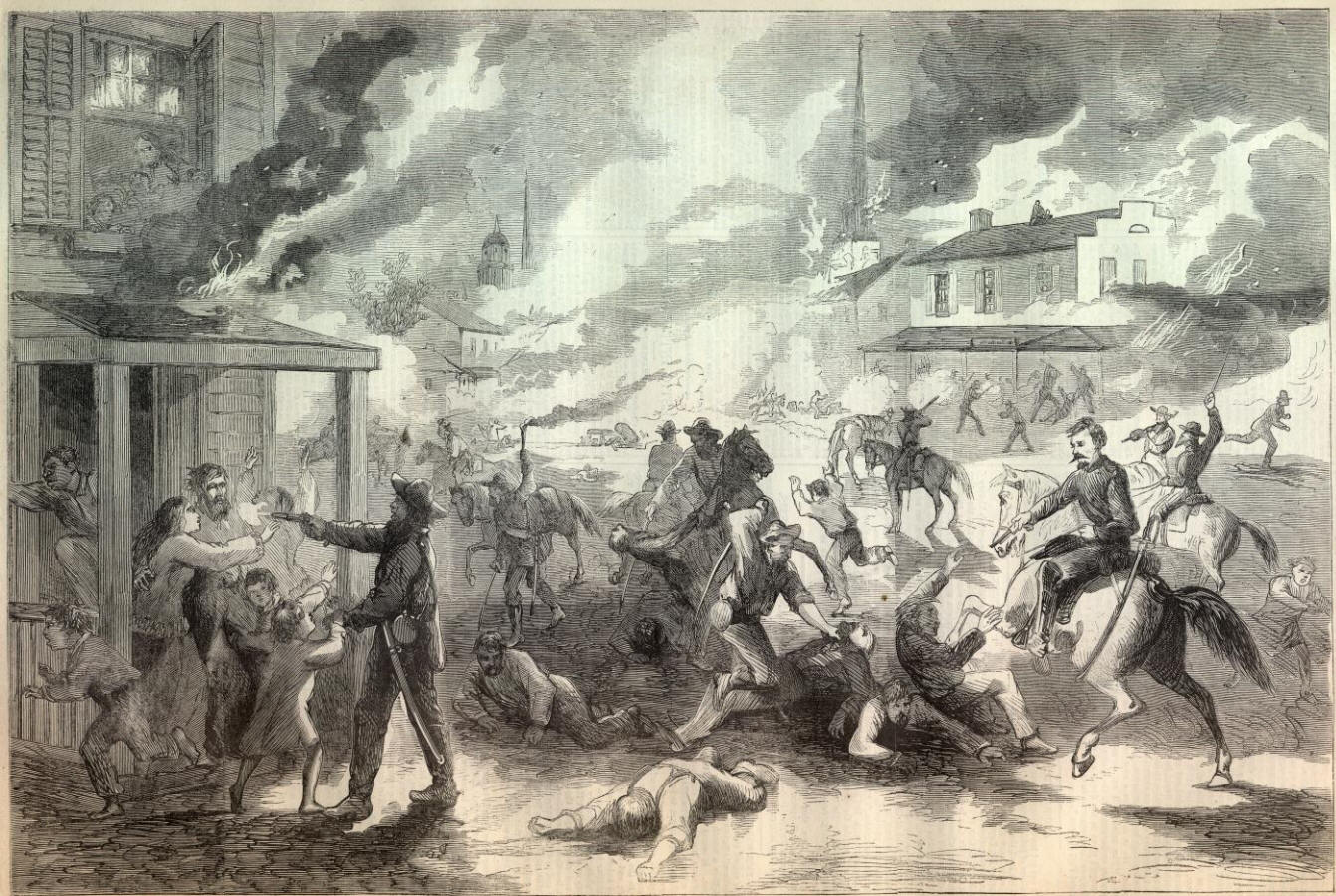 |
| The Attack on Lawrence (Harper's Weekly) |
HDQRS. ACTG. ASST. PROVOST-MARSHAL-GENERAL FOR KANSAS, NEBRASKA, COLORADO, AND DAKOTA,
Leavenworth City, August 25, 1863.
Colonel JAMES B. FRY,
Provost-Marshal-General, Washington, D. C.:
COLONEL: I have the honor to submit for your information the following brief report of facts connected with the destruction of Lawrence, and the books, records, and enrollment lists of the provost-marshal's office for the Southern District of Kansas.
I make this report from personal observation, as I was in Lawrence on the morning of the massacre and barely escaped the clutches of the guerrillas.
The attack was made by the notorious guerrilla chief Quantrill, with a force of about 300 men, at sunrise on the morning of Friday, the 21st instant.
The guerrillas entered the city from the south, and at once commenced an indiscriminate murder of its citizens. the work of death was continued for three hours, and whenever a citizen made his appearance, or escaped from a burning building, he was shot down in the streets.
Fires were set to buildings in all parts of the town, and all the business portion of the city and many of the private residence were burned. In many instances men were murdered in their homes in the presence of their wives and children, and the dead bodies burned. With the exception of those who were shot down in attempting to escape, the citizens were first robbed and then murdered.
Up to the present time 150 dead bodies have been found, and many more will doubtless be found in the ruins.
The provost-marshal's office, with all the records, papers, and enrollment lists, was entirely destroyed, and Captain Banks was taken prisoner and held during the occupancy of the town.
The value of the property destroyed will reach $2,000,000, and the money secured by the guerrillas cannot be less than $100,000.
A fearful state of excitement exists throughout the State of Kansas, and the people are unanimous in attributing the Lawrence massacre, and the present deplorable state of affairs upon the border, to the policy now being pursued by the commander of the Department of the Missouri.
The guerrillas have been largely re-enforced by men from Price's army, and have never been so active and defiant as now. From this time forward the war on this border promises to be one of extermination. Two or three thousand of the citizens of Kansas are in arms, and bidding defiance to the policy of General Schofield and General Ewing. They re determined to invade Missouri for retaliation. I am of the opinion that this result will be inevitable, taking into consideration the determined character of the people of Kansas, growing out of a long border contest, testified by the massacre without parallel in the history of civilized warfare.
I have deemed this statement necessary to a full understanding of the peculiar condition of affairs in Kansas, and which must necessarily affect the administration of this bureau.
Asking for such instructions as you may think necessary.
I am, colonel, very respectfully, your obedient servant,
SIDNEY CLARKE,
Captain and Actg. Asst. Provost-Marshal-General.
Official Records, Series III., Vol, 3, Part 1, Pages 719-720.
The massacre of civilians at Lawrence, Kansas by raiders lead by William Quantrill is one of the darkest chapters of the American Civil War. The role of Kansas in the coming of the Civil War is well known and the divisions within the state well documented. That "redlegs" under Lane committed offenses against civilians is unchallenged, but the scale of the executions in Lawrence are without parallel. Quantrill had meticulously planned the raid and had lists of Unionists to be executed. His men left the town with very few casualties and portions of his command acted with great brutality without respect to the age of their victims. As Clarke here predicted, the inevitable result was widespread acts of revenge through western Missouri. The lawlessness of the American West after the war had some of its roots in the violence in Kansas.
No comments:
Post a Comment